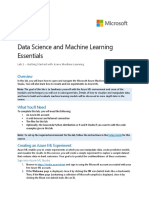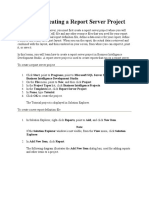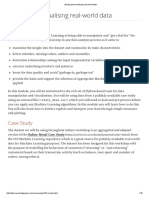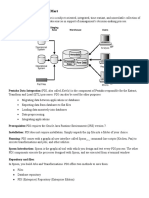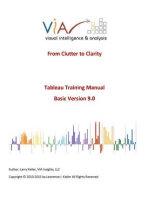Lab08S ExternalPackages
Lab08S ExternalPackages
Uploaded by
nishuCopyright:
Available Formats
Lab08S ExternalPackages
Lab08S ExternalPackages
Uploaded by
nishuOriginal Title
Copyright
Available Formats
Share this document
Did you find this document useful?
Is this content inappropriate?
Copyright:
Available Formats
Lab08S ExternalPackages
Lab08S ExternalPackages
Uploaded by
nishuCopyright:
Available Formats
BUSN5101: Programming for Business
Lab Eight: External Packages
Lab Eight: External Packages
Through the completion of this lab, you should be able to:
- understand and revise the use of ndarrays in program design;
- understand and revise the use of pandas in the design of data analysis programs;
- understand and revise the use of pandas in the implementation of data analysis programs.
The above statements are the learning outcomes of this laboratory and will be achieved in concert
with the other learning activities that you undertake for this unit.
Task One: Using ndarrays with numeric data
1. Utilising Pseudocode, design a program which generates a list of even whole numbers between
0 and 22 inclusive. Utilise the appropriate function to create a ndarray (numpy Array) with one
row and twelve columns (1x12) that stores this data from this list. Next, reshape this ndarray
so it is in the format of a 4x3 and a 3x4 ndarray, outputting both arrays to the user. Finally,
divide each element of the original array by two and output this changed array in the format of a
1x12 ndarray.
2. Convert your Pseudocode to Python code. If you are using Visual Studio Code, use pip to
install numpy and ensure you have created and utilised a new Workspace for this week. Then,
run the code and note any errors that you encounter. Correct any errors in your Pseudocode
and Python code and run it again, repeating until all errors are fixed.
Task Two: Processing and analysing data with pandas
3. The “Western Australia Budget Economic and Fiscal Outlook” for Financial Year 2015/2016 is a
financial report prepared by the Government of Western Australia. It details the actual,
budgeted and forward estimates of expenses for the state government. Appendix 8 of the
“Table and Chart Data” details the overall funding provided to various government operating
entities. Complete the following steps to begin your journey processing this data:
a. Firstly, download the tables from the Data WA open data portal by clicking the
“Download” button to the right of the large “Appendix 8” button as an Excel file – the
default option (click here).
b. Once you have done so, write Python code to read in Table 8.7 from the file using the
read_excel function, noting the specification of the sheet name from the
documentation (click here).
c. Print the DataFrame once it has been created and note its dimensions.
d. Then, remove any rows that contain cells with no data (as well as the first row with
column headers) and print the DataFrame again, noting the difference in dimensions.
e. Then, remove any rows that have quasi-no data (i.e. those with elements consisting of “-”
or “-(d)”). This can be achieved using the ‘tilde’ operator negating a statement (e.g.
~(the_df[“Column”] == “Value) as an expression). You may wish to output the
table to see if you have removed all elements in the process.
f. Finally, filter out any rows that are for values less than $5m in either the final financial
year or the one before it. Print the DataFrame again, noting the difference in dimensions.
g. Output descriptive statistics to the user. Postulate why they have been output the way
they have. Then, output the result to a CSV file named processed_data.csv.
UWA Business School Page 1 of 2
CRICOS: 00126G | PRV12169, Australian University
BUSN5101: Programming for Business
Lab Eight: External Packages
Task Three: Revision
4. Spend any remaining time you have revising previous materials you have used or work for
exercises you have created for this unit.
End of Lab Eight.
UWA Business School Page 2 of 2
CRICOS: 00126G | PRV12169, Australian University
You might also like
- Doconnell - Catholic Health Care Ministries ReflecitonNo ratings yetDoconnell - Catholic Health Care Ministries Refleciton4 pages
- Vikram Singh Bhati (Electrical Lead Engineer)No ratings yetVikram Singh Bhati (Electrical Lead Engineer)3 pages
- TEMPLATE Information Security Awareness and Training Policy100% (1)TEMPLATE Information Security Awareness and Training Policy3 pages
- University of Waterloo: CIV E 596 - Construction Management Computer Lab. On ExcelNo ratings yetUniversity of Waterloo: CIV E 596 - Construction Management Computer Lab. On Excel6 pages
- 05 Create Dax Calculations in Power Bi DesktopNo ratings yet05 Create Dax Calculations in Power Bi Desktop24 pages
- Object Oriented Programming Oops Lab ManNo ratings yetObject Oriented Programming Oops Lab Man39 pages
- Hướng Dẫn Thực Hành IT1016 - CTTT - Ver 1.0No ratings yetHướng Dẫn Thực Hành IT1016 - CTTT - Ver 1.014 pages
- Reading and Writing Data, Data ManipulationNo ratings yetReading and Writing Data, Data Manipulation6 pages
- Lesson 1: Creating A Report Server Project: Business Intelligence Development StudioNo ratings yetLesson 1: Creating A Report Server Project: Business Intelligence Development Studio17 pages
- Project Brief For Recruitment Tracker Dashboard CreationNo ratings yetProject Brief For Recruitment Tracker Dashboard Creation3 pages
- Mining and Visualising Real-World Data: About This Module100% (1)Mining and Visualising Real-World Data: About This Module16 pages
- Tableau Training Manual 9.0 Basic Version: This Via Tableau Training Manual Was Created for Both New and IntermediateFrom EverandTableau Training Manual 9.0 Basic Version: This Via Tableau Training Manual Was Created for Both New and Intermediate3/5 (1)
- The Data Detective's Toolkit: Cutting-Edge Techniques and SAS Macros to Clean, Prepare, and Manage DataFrom EverandThe Data Detective's Toolkit: Cutting-Edge Techniques and SAS Macros to Clean, Prepare, and Manage DataNo ratings yet
- How To Develop A Performance Reporting Tool with MS Excel and MS SharePointFrom EverandHow To Develop A Performance Reporting Tool with MS Excel and MS SharePointNo ratings yet
- University of Mumbai: 2019 Examination Time Table PROGRAMME - B.E. (Mechanical) (Choice Based)No ratings yetUniversity of Mumbai: 2019 Examination Time Table PROGRAMME - B.E. (Mechanical) (Choice Based)1 page
- Caitlyn Hamilton Resume and References 2No ratings yetCaitlyn Hamilton Resume and References 24 pages
- Postulates of The Theory: 1900s Paul Drude Electrons Kinetic TheoryNo ratings yetPostulates of The Theory: 1900s Paul Drude Electrons Kinetic Theory9 pages
- Math - 15 Math Worksheets That Sharpen SkillsNo ratings yetMath - 15 Math Worksheets That Sharpen Skills27 pages
- The ADC of The AVR: Analog To Digital ConversionNo ratings yetThe ADC of The AVR: Analog To Digital Conversion25 pages
- M.E. Production Engineering - Manufacturing & AutomationNo ratings yetM.E. Production Engineering - Manufacturing & Automation41 pages
- Eco Umberto Serendipities Language and Lunacy 1998No ratings yetEco Umberto Serendipities Language and Lunacy 199810 pages
- Feedback Linearized Model of DC Motor Using Differential GeometryNo ratings yetFeedback Linearized Model of DC Motor Using Differential Geometry6 pages
- Post-Exam 2 Practice Questions - Solutions 18.05, Spring 2014 Confidence IntervalsNo ratings yetPost-Exam 2 Practice Questions - Solutions 18.05, Spring 2014 Confidence Intervals7 pages
- Chapter 2: Forward Kinematics: RoboticsNo ratings yetChapter 2: Forward Kinematics: Robotics38 pages














